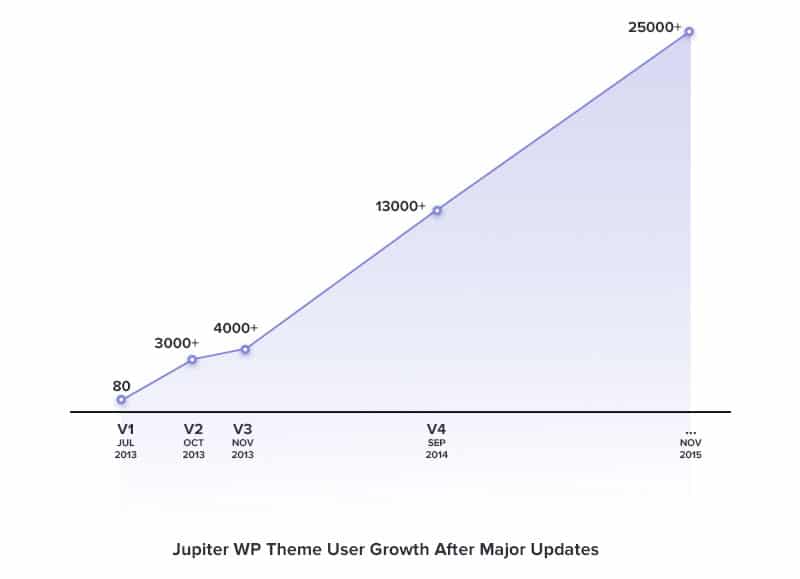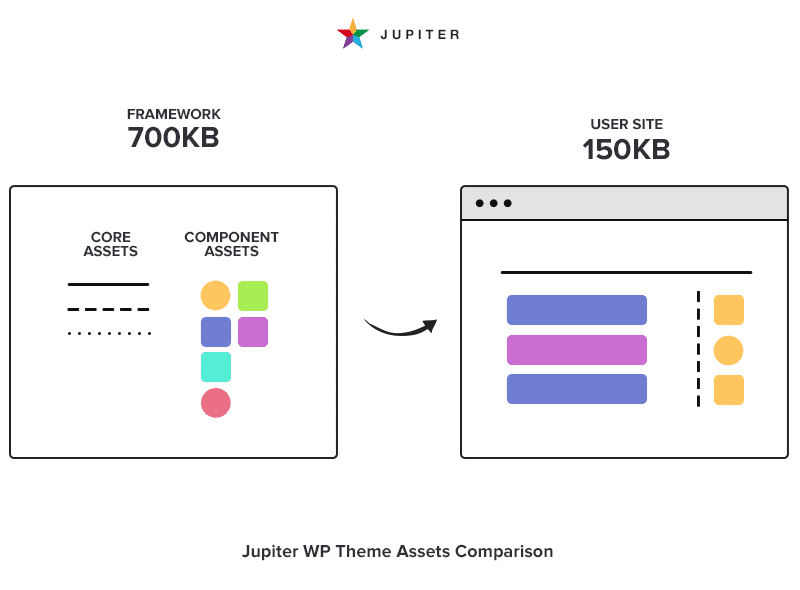Sure, “Regular Updates” can be an overly used catch phrase that everyone promises in the theme market as a selling point in their advertisements, but the truth is that we are living in an era where updating large WordPress themes requires more extensive and purposeful reasons to take place than just delivering the security patches and mere plugin fixes. The new WP era, as we depicted earlier, will require independent theme authors to provide updates to their application as a real added value to the product, but not just any regular updates—we’re talking about updates that double or even triple the performance, functionality, versatility and most importantly, the user experience.
At Artbees Themes, we had quite an unusual problem earlier last Summer when we were brainstorming what would be the next major update for our popular WordPress theme Jupiter. With more than 25,000 happy users, we considered whether we even had enough reasons to release a big update that would potentially throw a wrench in the existing platform. After all, Jupiter had and continues to be doing very well within its two and a half year lifetime, gathering a large user base and showing steady growth week by week, month by month and year by year. Especially after its latest major update V4 in September 2014 its growth and popularity grew more than ever.
Not to toot our own theme-spawning horn, but after this update we went a whole year without having to release anything more than just regular minor updates addressing bugs, plugin vulnerabilities and small user requested features. This left us wondering how we could still consistently improve Jupiter without compromising the core characteristics and functions that our users seemed to hold so dear.
If It Ain’t Broke Don’t Fix It, Right?
So we had to first answer a philosophical question as to why there should be a V5 at all when V4 has been doing so well. Specially after the release of our Artbees Themes portal, Jupiter’s sales peaked to a record high! Users were now able to register their installations and get access to an evolving template base with dozens of free templates to choose from and download on an unlimited basis with no time restrictions. We had ourselves a bit of a tug-of-war within our team as to whether we should take Jupiter in the direction of a new and improved V5 Update, or whether we should increase our user base by providing regular stability updates and turning our attention and time toward creating new templates. We looked to the Theme Producing Giants of the industry and saw that when encountering this same debate, they had chosen the latter route as a testimony to the quality of their existing product. We didn’t see frequent major updates to WordPress themes, what we saw was new templates being introduced and additional skins, looks and styles being constantly added to the existing themes.
So…To Update or Not To Update?
To answer this question, let’s take a look at the implications of updating large WordPress themes. Let’s say that having a 10K plus user record is considered a large theme. Now, what a large user base means generally include the following characteristics:
- larger layout variations that a user may create
- more installations with tweaked code for customization
- larger shortcodes repository that has evolved into an untouchable load of bloated code you cannot do anything but leaving it for itself!
- small user requested features added over minor updates will make the theme heavy over time and that becomes harder/impossible to touch over time.
All of the above factors can make it risky to apply fundamental changes to your product even with the purpose of increasing the performance, compatibility and functionality. Hence, the great hesitation felt by most theme producers when faced with whether to release a major update or not.
How we voted in favor of our users
Now that we’ve covered both sides of the argument, we had to not only find a convincing enough reason why a V5 is important at all, but also think about the possible workarounds to this seemingly two-sided debate. When in doubt, list your pros and cons! This is what we came up with—want to hear the bad news or good news first?
The downsides:
- Long project duration. You may very well end up spending a good five months on an update, rather than taking that time to create niche templates or even a completely brand new product
- A lot of installation and/or layout break reports and hence large support load to handle
On the plus side:
- Smaller theme (up to three times less than its current 15MB size)
- Extendibility via add-ons
- Increased speed and better browser performance by refactoring Javascript and CSS
- new features
The truth is that apart from a mere possibility, a larger portion of our customers would be negatively affected by a major update. Remember, the first to benefit from such a major update needs to be our users so if we could find a way to achieve all these pros while trying to reduce the chance of an update break (which is inevitable at least for a portion of users of any product) a Jupiter V5 would make everyone happy, most importantly our Jupiter users!
So How Can Jupiter Be Improved?
Below I will elaborate on Jupiter’s potential areas of improvement and how all those points relate to each other and will ultimately serve to achieve the pros listed above. Besides its greatness, the first thing apparent to everyone’s eye about Jupiter is quite straightforward— it’s a really large theme.
What Can Go Wrong with a Large WP Theme?
As was previously stated, Jupiter is a hefty WP theme with a solid foundation that has grown on demand over time. The additions we have made to this theme over its two and a half year lifetime has increased its size by three times. Well, a large WP theme in itself is not a bad thing, as you can find many large WP themes doing well out there, but well, when arrive at this state you should consider your theme in its entirety again and compare its status with the future you have envisioned for it. If you’re expecting a thriving future and even a larger user base the first thing you should be cautious about is the trap of becoming a bulky theme. This is how your WP theme will be like when it has grown without a solid plan:
Difficult to Install
The first and basic problem you will face after buying a heavy WP theme is that you will have to upload a larger WP zip file to your host in order to install it on your server. Most of the standard web hosts have an upload limit of 15MB and so if your WP zip file is bigger than that size, that would create some problems. Some hosting providers don’t even allow higher upload limits and some will ask you to change your plan to increase it.
Theme lock
A large WP theme means lower control over your future of your website. Let me make this more meaningful by replacing the word ‘large’ with ‘bulky’. Yes bulky themes -as they have grown improperly and not with future in mind- mean a lot of shortcodes, a lot of custom post types, a lot of third party plugins and a lot of —let me call it— useless stuff which will never be used by you for your website. If you are planning starting a large or heavy-duty website with these themes, chances are not really high you can ever imagine to migrate from them to any other theme without losing much of your content. And that will make you more inclined to stick with what you already have. This is actually how a theme can lock you into a co-dependent relationship with itself.
Large Assets
As was mentioned in previous sections, larger themes may leave you with an unnecessarily large website with large assets. In order to deliver their promise to give you ‘the last WP theme you will ever need’, ‘a theme for a lifetime’, or ‘a theme with infinite customizability’, they have to deliver a lot of styles and that will create large CSS and JS files. Let me give you a small example:
So let’s say you want a website for your small business with a five-page template and a blog. That would require 10 shortcodes, 5 widgets, a slider and a blog loop. Let’s assume the amount of actual CSS that browser has to process to render a whole website is 150 KB but the CSS file it has to process within a big WP theme is a large 700KB including the CSS for all the styles available in the theme, even the ones you haven’t and don’t even plan on using in your website. See? Not so practical is it?
Maintenance Challenges
Not only is it difficult for end users who want to customize a bloated theme, it’s more challenging for developers to contribute to their own themes via updates. A bloated theme will make the update process harder. Since there is no underlying solid development plan things can easily get out of control and result in unpredicted case scenarios by providing updates.
A WordPress Theme’s Size Can Be the Biggest Barrier for Its Future Growth
Having touched on the different points of theme, maintenance, we acknowledge that the future of your theme can consequently be affected by an endless void of extendibility. The concerns of size and side effects on the user’s end may make you wary about your update policies and require your having to add on-demand, user-requested features one after the other until you end up with a bloated mass of untouchable codes and plugins headed right toward a bulky mediocre multi-purpose WP theme monster. Though if you intend to survive in an agile and ever-evolving web industry and keep up with the competition you need to check if your theme has the proper infrastructure for extension and iron out any wrinkles that may keep you from further growth in the future.
What do we mean when we talk about extendability?
- We are referring to a modular framework within which you can attach or detach the components or what we call ‘modules’ according to what you need. People can easily manage which shortcode they want and which shortcode they do not want to store in their installation. If they change their mind, they can simply go to Add-Ons section of the Artbees Themes portal and download them back to their theme. They can install new components in form of Add-Ons from Artbees Themes portal.
- The amount of content loss will be much lower if they decide to transfer to another theme. This framework will generate two kinds of assets:
- CORE ASSETS: Will include the codes that build up the theme’s basic and fundamental look
- COMPONENT ASSETS: Will include the styles and scripts based on users’ used components (shortcodes, sliders, widgets, etc.) while being bound to render the core assets, the theme will combine and serve assets that are technically used in your website. Therefore browser will then only download and render the CSS for the components you have used in your pages and not all of the component available in the theme.
Mission Is Clear. What Is the Solution?
So up to this point we have found answers to many of our questions about why a major update is important for Jupiter and how it can help the product by adding a real value to it. We are sure that Jupiter’s current and future users will thank Jupiter for giving them a small, modular and extendible framework by which they can achieve a lot with not much. Such a jupiter will assure meeting all the objectives we mentioned in our pros section. Creating such a Jupiter from what it is right now is however no easy job and will demand a general revision in the application. That being said, we’ve made up our mind to release a major update for our Jupiter, but the big remaining part is to see how we can reach towards the state we have envisioned. In the next article we will cover the pathway we took to revise the application architecture, the problems we had to solve, the methods we employed to address them and the outcome. Stay tuned!





2 Comments
Interesting post for sure. As a loyal customer we’ve loved working with Jupiter it’s a solid theme that has endless possibilities creatively. It’s going to be interesting to see what this new update brings (and how much it breaks!!) but will keep an eye on it.
Best of luck with the updates!
Thanks for the comment Matt! Here at Artbees Themes we’re doing our best to make the migration process as seamless as possible. We hope the outcome would be great enough to excite you and all Jupiter users 😉
P.S Sorry for the late reply, I have missed it